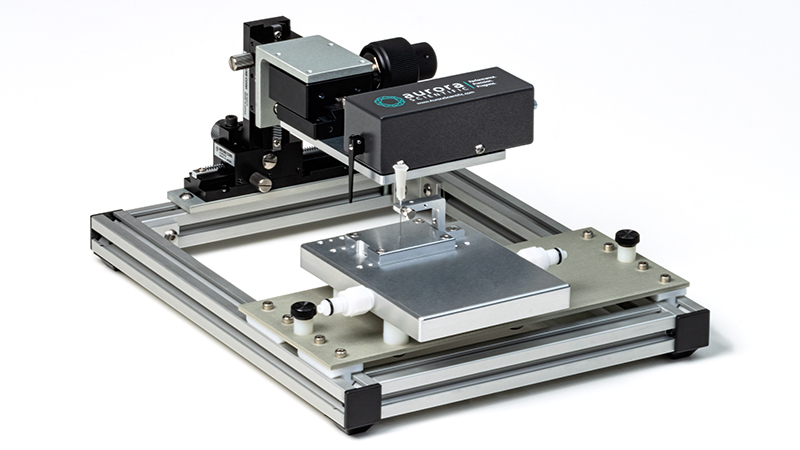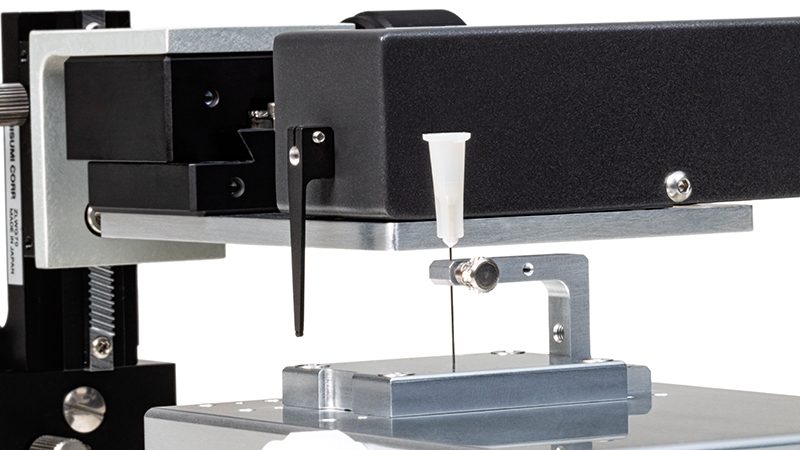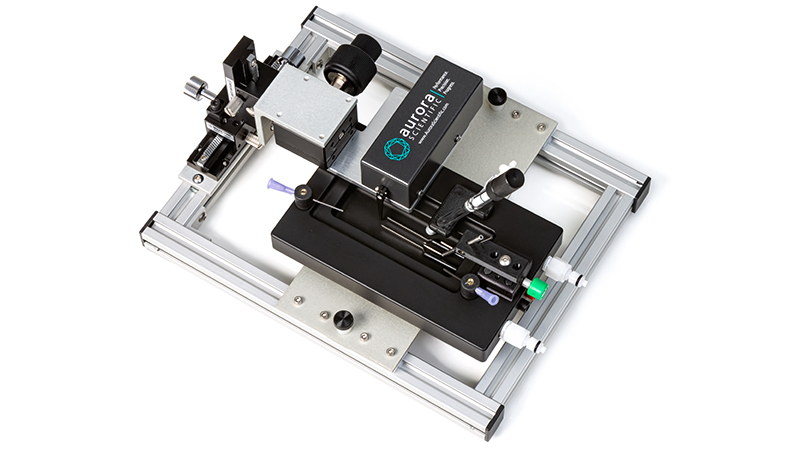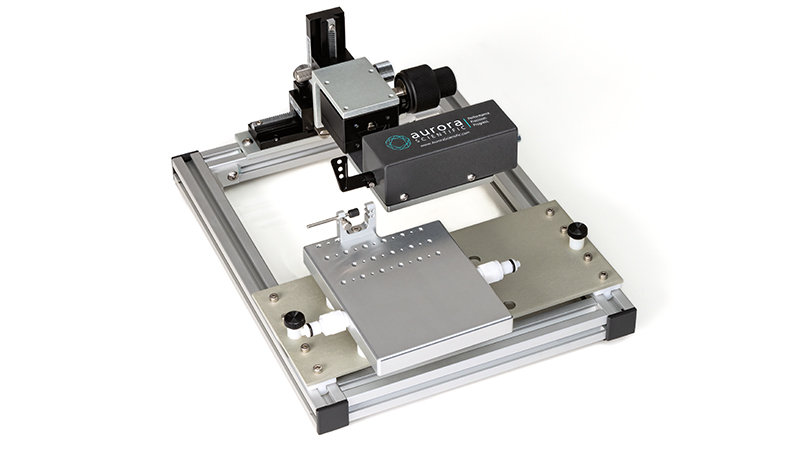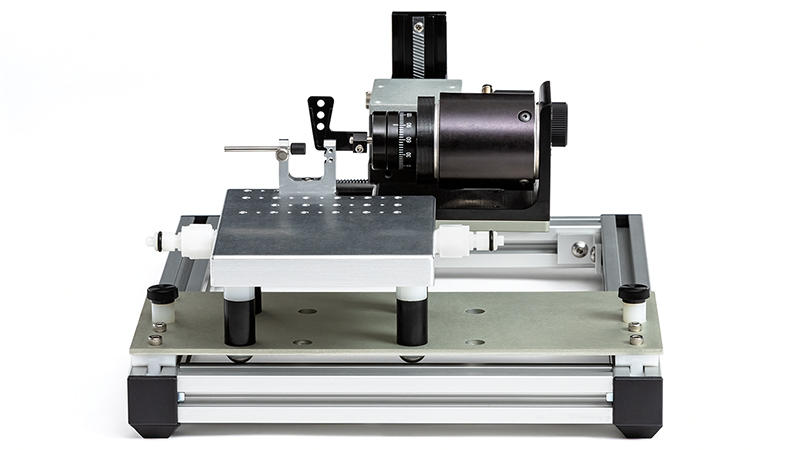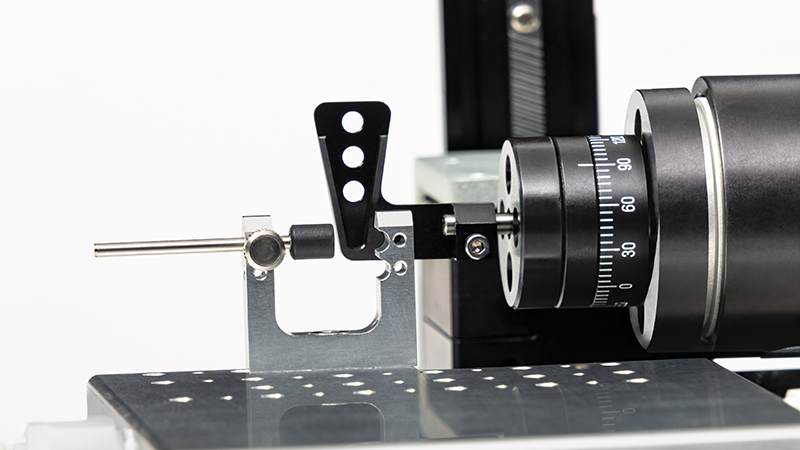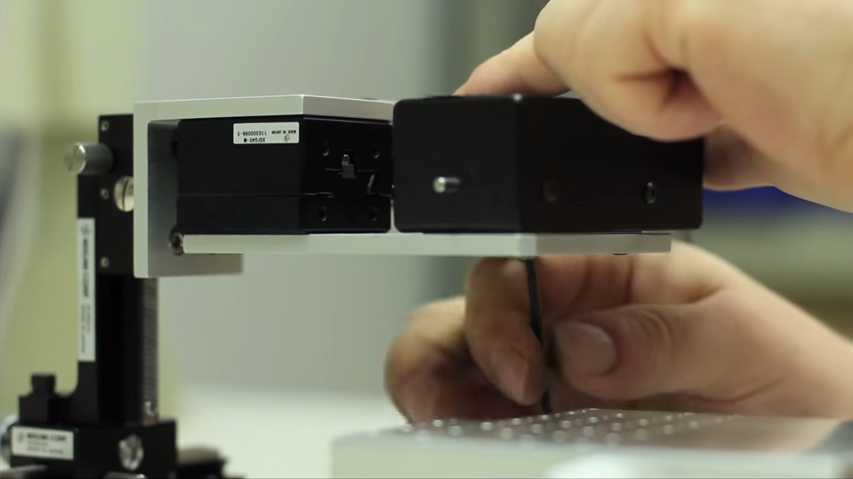809C: in-situ Mouse Apparatus
The 809C mouse apparatus performs three different tests for measuring muscle properties using a single, easy-to-use platform. In two of these configurations, the apparatus is mounted with an animal and limb plate for measuring contractions in-situ (using a lever arm) or muscle dynamics in-vivo (using a footplate). The third configuration involves the addition of a 25mL horizontal in-vitro bath, enabling contractile measurements in isolated, intact muscle using a lever arm.
The animal platform is temperature-controlled and adjustable to ensure clear access to the animal while positioning the limb. A variety of limb clamps for specific applications and research subjects are also available, creating greater ease of use during examination.
The 809C is compatible with our 300E series of muscle levers and 490 series of torque transducers . All models are mounted on slides to position the lever easily with respect to the limb. Motor mounts also provide a fine translation stage to properly set resting tension of the muscle.
Variant
in-vitro Bath Variant:
809C-IV in-vitro Mouse Apparatus:
Perform in-vitro experiments on intact mouse muscle in the 25 mL horizontal bath
Stories of Success
809C – in-vitro Configuration Sheds Light on the Relationship Between Muscle and Nerve
CHALLENGE
In 2010, Dr. Katherine Wilkinson, then a postdoc at Emory University, approached us about equipment for testing EDL muscle from mice. Specifically, Dr. Wilkinson was interested in sensory neurons innervating the skeletal muscle and how these neurons fire in response to various mechanical, chemical and other stimuli from the muscle.
To perform these studies Dr. Wilkinson required an in-vitro bath for her apparatus that could permit stretch and stimulation of the muscle, but still allow clear access to the isolated nerve-muscle preparation for recording equipment and electrodes.
SOLUTION
The 809C in-vitro configuration (then still a model 809B) was used to complete these experiments. Dr. Wilkinson was one of the first to use the apparatus in this configuration and the spacious, minimal design allowed easy access to the innervated preparation for attachment of the muscle and most importantly to place the necessary electrodes in order to record from the sensory nerve. Temperature control and means for changing the perfusate solution were also included with the system, enabling convenient manipulation of muscle stimuli.
RESULTS
The chamber was instrumental in the completion of Dr. Wilkinson’s postdoctoral research at Emory. Our design permitted simultaneous nerve and muscle recordings in response to a variety of stimuli. It worked so well that today she uses two instruments in her new laboratory at SJSU. Dr. Wilkinson also used the chamber as part of a recent JoVE methods paper about her fascinating research, as well as highlighting it in many other publications.
809C Helps Neuroscientist Assess Muscle Function in Model of Peripheral Nerve Injury
CHALLENGE
Dr. Young-Jin Son at Shriners Hospitals Pediatric Research Center studies peripheral nerve regeneration and the role Schwann cells play in maintaining and aiding regeneration of synaptic connections. Dr. Son was looking for a way to test functional recovery in mice with peripheral nerve injury in addition to measuring number of motor units and neuromuscular junction (NMJ) properties.
Dr. Son was well-versed in electrophysiological recordings, however, he wanted a way to test muscle function in response to regenerating sensory and motor afferents as well as determining the quality of re-innervation.
SOLUTION
Due to the numerous parameters to be measured and different preparations required, Aurora Scientific knew the 809C apparatus would provide Dr. Son the configurability he needed. The 809C whole mouse apparatus combined with our flagship 300C Dual-Mode lever provided a cost effective way to quickly perform in-situ or in-vivo measurements in mice. Aurora Scientific also included our 809C-25 bath which attaches to the 809C apparatus to enable in-vitro measurement of nerve-muscle preparations.
RESULTS
With Aurora Scientific’s 3-in-1 system, Dr. Son has the ability to perform isometric muscle force measurement in mice, which is known to be an indicator of functional recovery in models of peripheral nerve regeneration. In addition, Dr. Son found great use of our in-situ configuration, which allows him to measure isometric force in specific muscles while maintaining vascular and neural connections. Furthermore, our in-vitro bath has allowed Dr. Son to use a nerve-muscle preparation to measure number of motor units as well as test NMJ properties in these models. The long term goal of his lab is to be able to perform longitudinal studies to measure functional recovery in-vivo in response to various treatment regimes. Aurora Scientific’s 1300A system provides the versatility that Dr. Son requires and will allow him to measure mechanical properties as his research progresses.
Select References
- Norden, Diana M. et al “Tumor growth increases neuroinflammation, fatigue and depressive-like behavior prior to alterations in muscle function.” Brain, Behavior, and Immunity (2015) DOI: 10.1016/j.bbi.2014.07.013
- Kobayashi T. et al “The timing of administration of a clinically relevant dose of losartan influences the healing process after contusion induced muscle injury.” Journal of Applied Physiology (2013) DOI: 10.1152/japplphysiol.00140.2011
- Neelakantan et al. “Small molecule nicotinamide N-methyltransferase inhibitor activates senescent muscle stem cells and improves regenerative capacity of aged skeletal muscle” Biochemical Pharmacology (2019) DOI: 10.1016/j.bcp.2019.02.008
- Zhu Z. et al. “Sarcolemmal ATP-sensitive potassium channels modulate skeletal muscle function under low-intensity workloads.” The Journal of General Physiology (2014) DOI: 10.1085/jgp.201311063
- Coulson et al. “Regulation of muscle pyruvate dehydrogenase activity and exercise fuel use in high-altitude deer mice” The Journal of Experimental Biology (2024) DOI: 10.1242/jeb.246890
- Distefano, Giovanna et al. “Neuromuscular Electrical Stimulation as a Method to Maximize the Beneficial Effects of Muscle Stem Cells Transplanted into Dystrophic Skeletal Muscle.” PLoS ONE (2013) DOI: 10.1371/journal.pone.0054922
- Sergeeva et al. “Mechanical and signaling responses of unloaded rat soleus muscle to chronically elevated β-myosin activity” Archives of biochemistry and biophysics (2024) DOI: 10.1016/j.abb.2024.109961
- Koganti Siva R.K. et al. “Disruption of KATP Channel Expression in Skeletal Muscle by Targeted Oligonucleotide Delivery Promotes Activity-linked Thermogenesis.” Molecular Therapy (2015) DOI: 10.1038/mt.2015.21
- Ambrosio, Fabrisia et al. “Arsenic induces sustained impairment of skeletal muscle and muscle progenitor cell ultrastructure and bioenergetics.” Free Radical Biology and Medicine (2014) DOI: 10.1016/j.freeradbiomed.2014.06.012
- Franco, Joy A. et al. “An in vitro adult mouse muscle-nerve preparation for studying the firing properties of muscle afferents.” The Journal of Visualized Experiments (2014) DOI: 10.3791/51948
Related Products
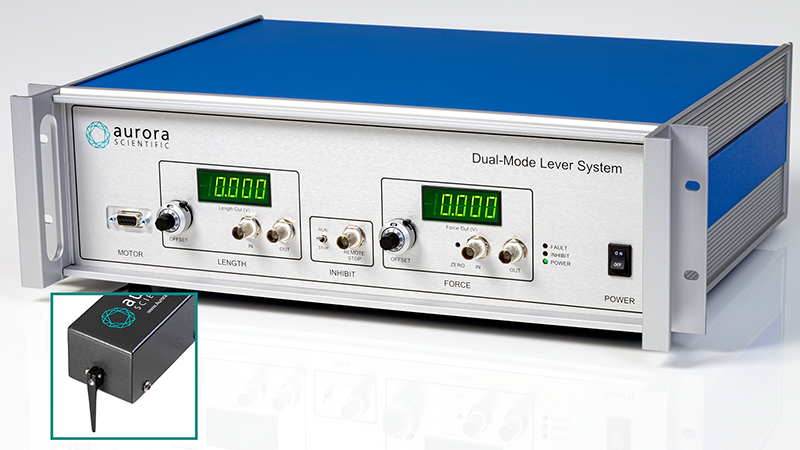
300E: Dual-Mode Muscle Levers
Seamless, flexible control of force and length, with the unique ability to measure one or both in a single and convenient lever system.
Learn More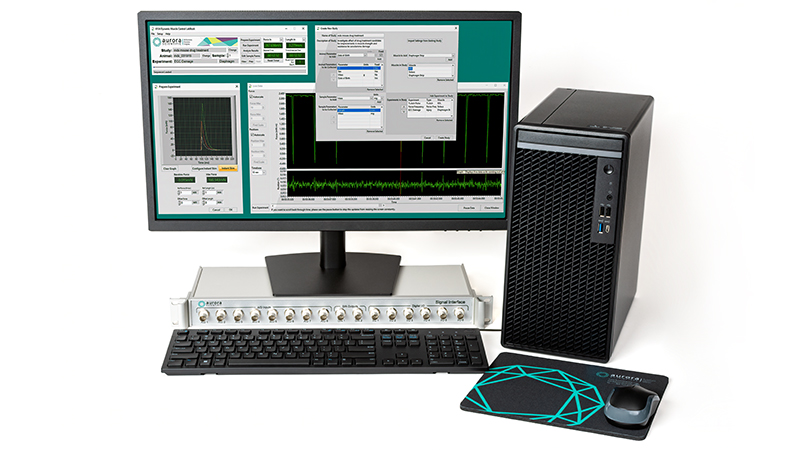
605A: Dynamic Muscle Data Acquisition and Analysis System
Precise, custom software designed for real-time data acquisition, instrument control and data analysis with unique, integrative features. Includes force and SL control capability
Learn More
701C: Electrical Stimulator
Our high-powered, bi-phase stimulator designed for muscle researchers conducting the most demanding field stimulation protocols.
Learn More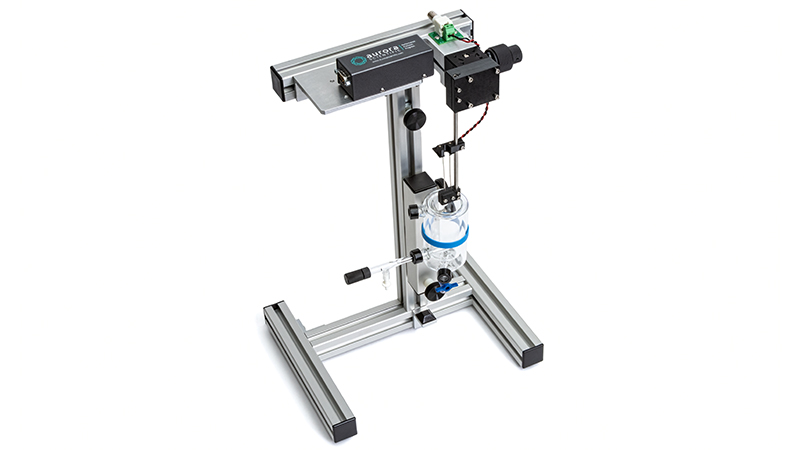
800C: in-vitro Muscle Apparatus
Flexible design makes these systems the ideal choice for measuring muscle properties of intact muscle tissue in mice and rats
Learn More
150A: Integrated Muscle Test Controller
The 150A Integrated Muscle Test Controller is a new family of integrated instruments which combine a standard Aurora Scientific 300C Series Dual-Mode Lever System, 701C Stimulator and USB Data Acquisition hardware into one standard-sized enclosure.
Learn More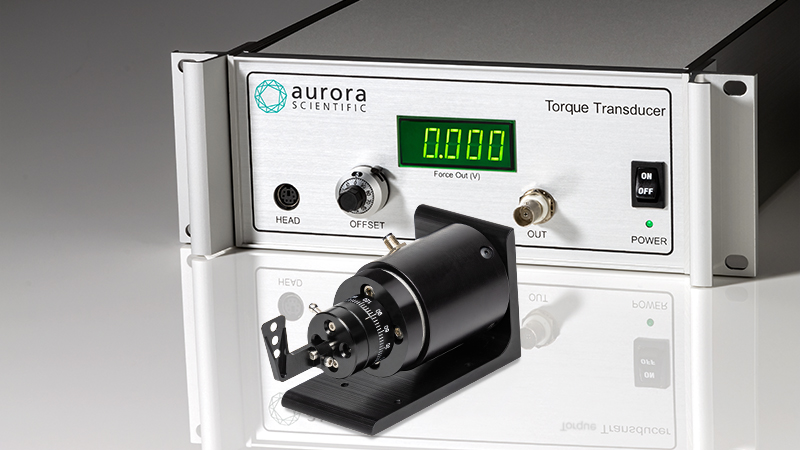
490A: Torque Transducer
The 490A series of isometric torque transducers are a series of rotational load cells that are designed primarily to enable in-vivo contractile measurements made across the joints of various animal models.
Learn More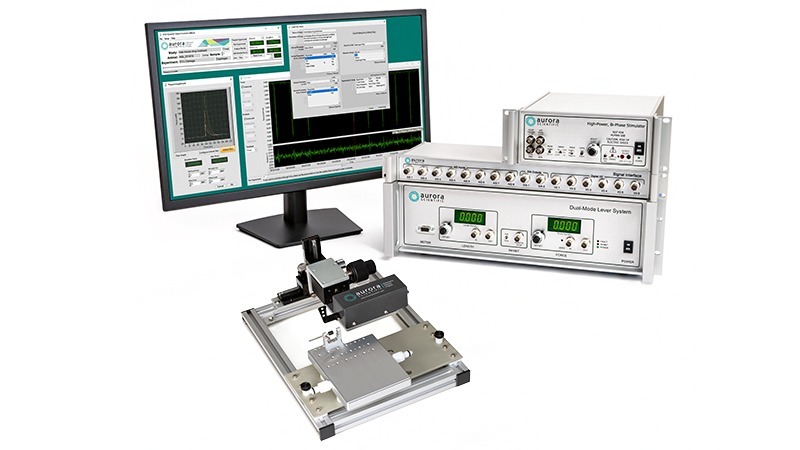
1300A: 3-in-1 Whole Animal System for Mice
The 3-in-1 Whole Animal System provides flexible and accurate measurement of rodent muscle properties in-situ, in-vivo and in-vitro.
Learn More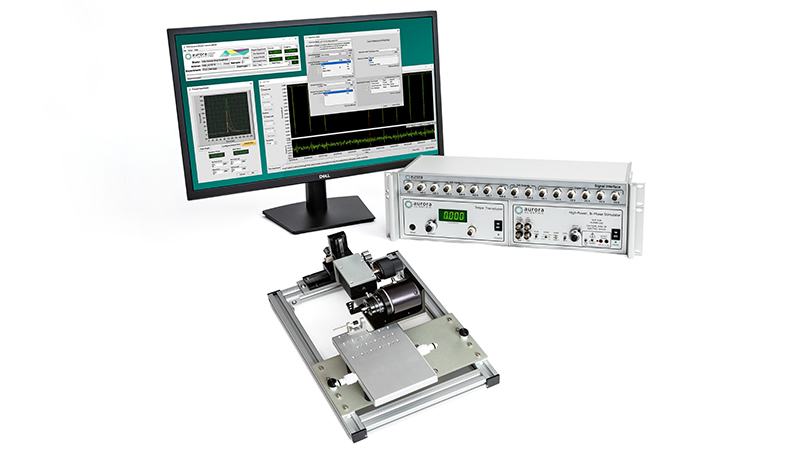
1301A: Isometric Whole Animal System for Mice
The all-new 1301A Isometric Whole Animal System enables simple, high-throughput isometric only footplate experiments to accurately measure in-vivo muscle function in mice
Learn MoreSpecifications
| Apparatus | 809C |
|---|---|
| Animal Platform Dimensions [mm] | 90 W x 115 L |
| Platform Horizontal Movement [mm] | 100 |
| Lever System and Torque Transducer1 Movement [mm] | Vertical: 41 Side-to-side: 125 |
| Resting Tension Adjustment [mm] | ±10 |
| Tension Travel per Knob Rotation [mm] | Course: 20 Fine: 2.6 |
| Limb Clamp Fixation | 26 mounting locations |
1 = Compatible with 300E and 305E lever systems and 490A torque transducers
| Temperature Control | 809C |
|---|---|
| Type | Circulated heated water |
| Fittings | Dry-break, quick connect |
| General Specifications | 809C |
|---|---|
| Weight [kg] | 1.7 |
| Dimensions [cm] | Overall: 21 W x 28 L x 12 H Frame: 21 W x 26 L x 12 H |
Explore Further

Applications of In Vivo Functional Testing of the Rat Tibialis Anterior for Evaluating Tissue Engineered Skeletal Muscle Repair
We describe an in vivo protocol to measure dorsiflexion of the foot following stimulation of the peroneal nerve and contraction of the anterior crural compartment of the rat ...
Learn More
